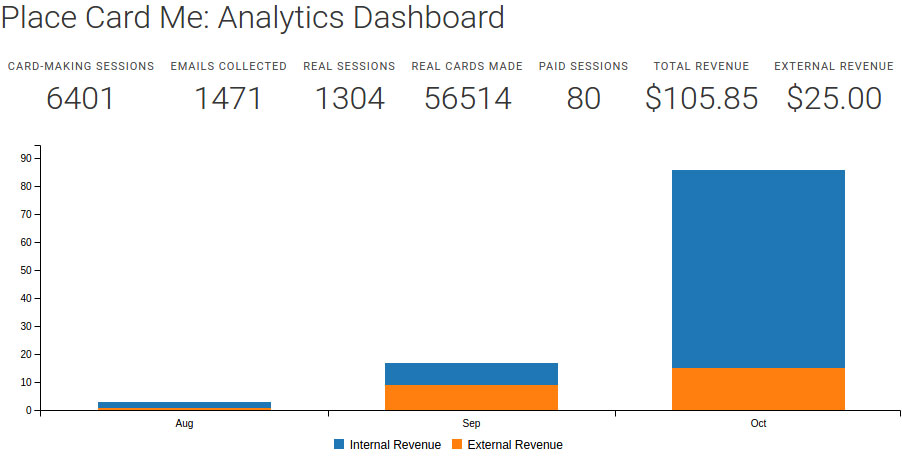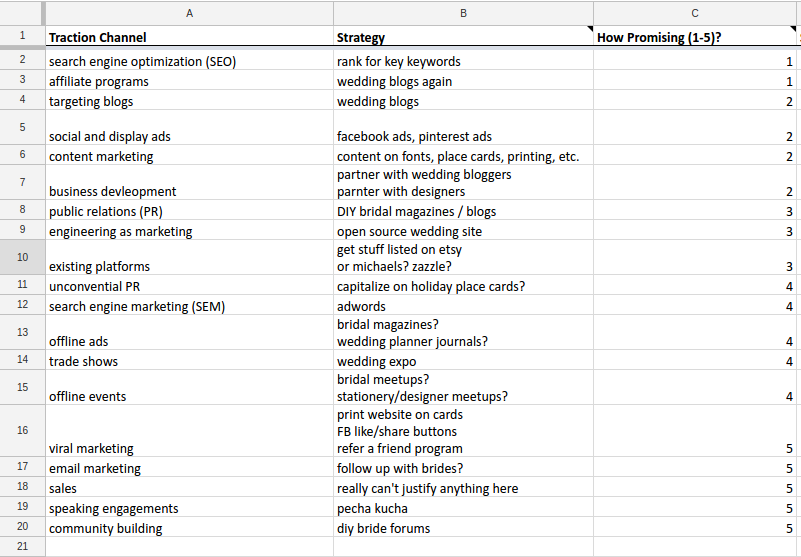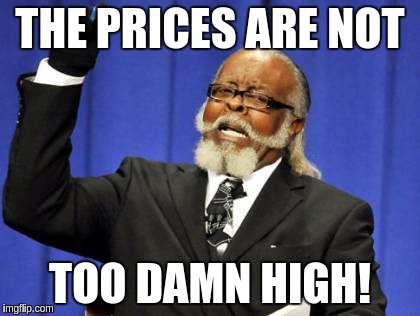Two months ago Place Card Me, my little place card making website and SaaS-building testbed made its very first dollar.
Two months later, towards the end of October, it passed another major milestone: $100. With a few more sales it will pay back every dollar I’ve put into it so far!
Moreover, if you ignore the Y-axis, the revenue growth looks great so far:

I’m now convinced that barring any surprising unforeseen changes (like Google deciding to kill my search rankings or a new heavyweight competitor jumping in) it will be feasible—if not easy—for the site to become a steady source of passive income, maybe one or two hundred dollars a month.
Pretty great, right?
Honestly, I am stoked. There were many times where I thought I was going to fail to earn a single dollar in six months. That would have been—among other things—super embarrassing for me.
At $100/month, I can cover all my hosting costs, many of my lunches, and maybe even the occasional night on the town!
The rest of this post describes—in possibly more detail than necessary—exactly how that happened. And while a lot of what follows is specific to my own product, I hope the lessons and thinking can help guide and inspire others to continue to grow their SaaS businesses.
From $1 to $100/month
So it took me 5 months and 200+ hours to earn my first dollar. By comparison getting to $100/month was a cakewalk.
These were the major contributing factors—in approximate order of importance:
- My organic reach and top-of-the-funnel continued to grow.
- I picked up a new distribution channel.
- I started charging more.
That’s it! I’ll talk more a about each of these below.
The Compounding Effects of Reproducible Organic Reach
Many months ago—when I was first trying to figure out how to market my site—I read Traction.
The book outlines 19 different channels you can use to get traction for a product, and provides a methodology—called “bullseye”—for picking which ones to focus on. I found it to be super helpful in coming up with my overall traction strategy and I’d highly recommend it to anyone that isn’t sure where to start with marketing and selling their product.

When I did the “bullseye” exercise I selected SEO as as the number one channel to pursue. As a result, I set about learning SEO and adapting a strategy that worked pretty well. Through the techniques described in that article, I was able to slowly target certain keywords and phrases until my site started climbing the rankings in search. And as this happened, I started getting more and more organic traffic until eventually making that first joyous sale.
However what’s important to realize is that that sale wasn’t a miraculous single-event. It was the eventual conclusion of very simple game of probabilities.
One of out every N visitors to my site will eventually make a purchase. So if that first sale came after N visits, then the next sale should come after approximately 2N, and so forth. Therefore, if the rate of visits went up (which it did) then the rate of sales should also go up (which it also did). It’s just math!
So far, I believe that the biggest factor in my app’s increase in revenue over the last two months is simply that it’s getting way more traffic. More traffic = more sales, plain and simple.

As an aside, I now have enough data to know what my sales rate is and enough traffic to run A/B tests to try and move it—but that’s a subject for another time…
New Distribution Channels
The second increase in revenue came from a completely new distribution channel. That channel was Etsy.

Early on in my research of the wedding industry I learned that Etsy was an absolute behemoth in the space. In fact, a significant proportion of brides (and grooms) will search only on Etsy when they’re looking for things for their wedding.
Realizing this made me want to figure out how to get in on some of that Etsy action. The simple way to do this—which you’ve probably guessed—was to create a shop on Etsy and sell my place card templates there. This did require building out some tech to support a workflow centered around someone purchasing something on Etsy, but turned out to not be too complicated.
Those orange slices in the chart at the top—those are my Etsy sales. In September they were actually higher than my organic sales, though in October I toppled them with organic.
Unfortunately, I don’t quite know how to improve my organic reach on Etsy so the numbers seem to stay much flatter over time—at least so far. If anyone figures out how to exponentially grow a shop’s Etsy reach, I suspect they could make a lot of money! Also please let me know if you know how to do this. :)
Pricing Changes
The last thing I did to increase revenue was raise prices.
The way Place Card Me works is that you can use it for free, but certain templates on the site cost money. When I was deep in the trough of sorrow—wondering whether I would ever make a single sale—I dropped the price of all templates to just $1. After several back-to-back weeks of regular sales I decided to start bringing them back up.
Specifically I did three things:
- I eliminated all free designs except the “blank” one.
- I raised prices on most designs from $1 to $1.95.
- I started charging people who uploaded their own designs.
The combination of these changes actually increased sales rates. I believe that was mostly a result of removing the free designs—which I suspect created a psychological effect of making people think that they “should” have to pay for a design, and were therefore more willing to do so.

We developers are often very hesitant to raise prices. This gentleman provides some helpful advice.
One last funny anecdote: charging for custom uploads was actually an accident.
When I introduced the change that made all designs paid, I changed the default behavior of the site in a way that inadvertently caused the upload workflow to also cost money. The way I found out I had changed it was getting notified that someone had paid for a custom design! Of course—once that happened—I decided to keep the change in place. Custom design sales are now the most popular single template/option on the site.
What’s Next?
I’m quite happy to be at $100/month in revenue at the moment, but it’s still a long ways away from anything that might meaningfully get me on a road to passive income.
In the next installment of this series, I’ll talk about how I plan to try and grow that number by at least 10x. It should be fun! If you’d like to follow along you can subscribe on my website.
---
This post originally appeared on coryzue.com.

Hey, I know you! You're the Django wedding website guy! I was actually planning on using Place Card Me for my wedding next year. I found out about it through GitHub actually - if you search for "wedding website", your repo is the top result, and through there I found out about Place Card Me. Perhaps that could be a subtler "traction channel"? Especially given that anyone who is looking for a wedding website will also likely be looking for placecards.
EDIT: Oh wait, that is actually on your list! Nevermind then.
I think this will be the best thing I'll hear all day, maybe all week. :)
Yep that's me! Super cool you found the site through there! It was a traction tactic, although was more hoping to get backlinks and build up SEO than directly market to people interested in wedding websites. That's a good idea though! I will probably tweak the repo/blog a bit to see if I can subtly let people know about the site. Thanks for the idea!
Thanks for the write up. Your methodical approach is going to pay off - I can feel it.
We'll see! :)
great story and congrats on your success so far! ideas are a dime a dozen but for what its worth you might want to try this - seating guests is a pain point - you might want to have a lead magnet side site that helps people seat guests by uploading a straight guest list with numbered priorities and a separate list of people pairs that you dont want to seat next to each other. You can write a (semi random) algorithm that generates a whole table seating list and if the user wants to manually edit from there or whatever they can do that but they will have already entered in their name lists and from there its a click away to buying!
Thanks swyx! I love this idea and I know it's a pain point because I've had confused early validation calls where people thought that's what the site was doing (and were excited). It's a hard enough problem that I think it could be its own product in and of itself, but would definitely fit perfectly with place cards. Unfortunately, it's quite a bit more scope than I have time to bite off right now, but I think this deserves a place on the later stage traction list. Appreciate the suggestion.
I suppose one logical next step might be to allow designers to upload and sell their own designs from the site, either as a completely free thing (to draw customers to the site) or taking a small cut (Redbubble style). Also maybe add more font choices!
Nice, thanks for the suggestions! Both of these points have been on my list for ages and the designer/marketplace thing I think is a really interesting long term play that could have a lot of potential down the road. Since I have the "upload your own" workflow another twist on the concept would basically be revenue sharing/affiliate setups with designers so every time they sell a template on Etsy they can send a link to my site and we can split the revenue from the sale or something like that. It's high on my list of next traction channels after I exhaust Google.
Re: fonts - yeah, totally. I should really just do that ASAP. Been worried about page weight but I think there are probably either ways around that, or nobody will notice/care.
Also if you're looking for good fonts, I love these: http://hellohappy.org/beautiful-web-type/
Nice, these look great. I can't seem to figure out how to link through to the fonts on Google though.
Yeah... years ago they used to have links, don't know what happened. Now I just inspect the text and look at the computed font family style. All the fonts can be found via searching on Google fonts
Personal favorites are: Lato, Vollkorn, and Open Sans
I'm thinking, just humble suggestion ;) to give coupons or discounts to people who buy from you for their friends could be a great strategy to ensure that they spread the word. Image a bride who gets 5 coupons to give away to their friends; probably she already has some friends or relatives at the same age and preparing a wedding.
I'm enjoying to follow your journey ;) thanks for sharing
Thanks for the suggestion zano! Coupons is not something I had thought of but I think it's a really good idea!
Thanks for sharing.
Cool and useful site and where I will go to or refer people to if place cards are needed.
I am sure you will continue to grow over time, with some good potential for a high NPS and referral rate.
Thanks - really appreciate it. Yeah one great thing the site has going right now is that it's definitely the best thing out there for what it does right now, so really hoping some of that word-of-mouth referral stuff can pay dividends over time.
Have you started a blog/content marketing or thought about it?
Funny you should ask - I just wrote my first blog post when the site hit 100,000 place cards on the most interesting and unique place cards made with the site.
I don't quite know what else to write about though as I really don't know much about the market. I think the blog will likely end up being mostly a long-tail SEO game, e.g. "holiday place cards" and "thanksgiving place cards" etc. Hard to imagine random people waking up and wanting to read about place cards on the internet...
I am impressed with your numbers....I think this may be the perfect service to turn into a FaceBook Messenger ecommerce bot....
Huh that is not something I had considered. I'm a dinosaur that barely knows how to use Facebook messenger. How are you imagining that would work?
Your current ordering work flow is pretty straightforward and would seem to work well with FB Messenger using either a simple redirect to a webview or better yet using your site's API calls to generate transactions from and returning results to the bot. This enables the customer to use your service on their smartphone without having to load another app as it runs inside their usually already existing FB Messenger app. If you want to experiment I would sign up for ChatFuel.com which is free to use and has a lot of plug and play functionality built in without you having to do a lot of coding..The other upside is advertising using FaceBook ads which can take prospects directly to your ecom bot, either via phone or laptop, without the friction of leaving FB to be redirected to an outside site...adds a little credibility and discoverabilty as a bonus...
super interesting stuff - makes me realize how much I have to learn. thanks for the suggestion!
Very cool. Thanks for sharing your story and the tactics you used.
Thanks Josh!
This comment was deleted 6 years ago.